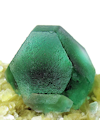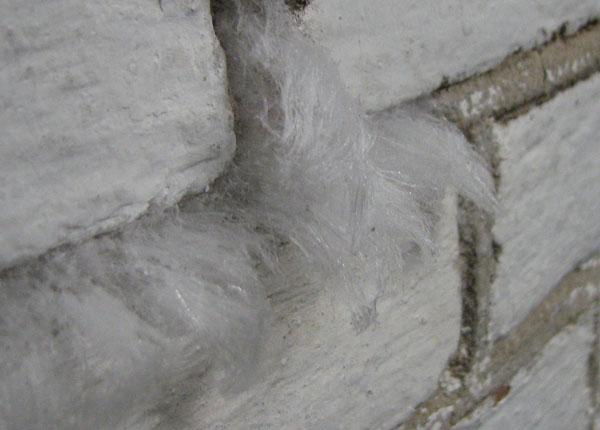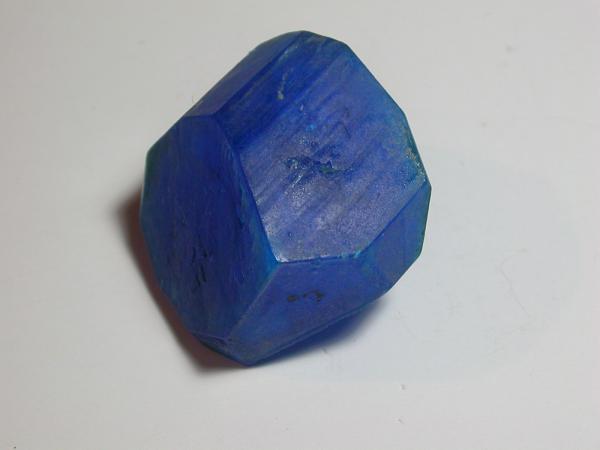| View previous topic :: View next topic |
| Author |
Message |
Paul S

Joined: 20 Mar 2010
Posts: 79



|
 Posted: Mar 23, 2010 13:45 Post subject: When a mineral can be called a mineral. Posted: Mar 23, 2010 13:45 Post subject: When a mineral can be called a mineral. |
|
|
This topic evolved from the following topic, where naturally looking, but synthetic coppersulfate crystals were discussed: https://www.mineral-forum.com/message-board/viewtopic.php?p=10805
The question is if you can call a mineral a mineral when there is even the slightest influence of men on its formation. If you grow a crystal out of a saline solution, it is clearly not a mineral. And a quartz crystal dug out of a geode is clearly a mineral. But what if the lowering of the groundwater level or the opening of a cavity generates the growth of crystals? Can they be called minerals, or do we label them as synthetic?
I think this is a very interesting question, for it investigates the boundary between natural and synthetic.
|
|
| Back to top |
|
 |
Carles Millan
Site Admin

Joined: 05 May 2007
Posts: 1471
Location: Catalonia



|
 Posted: Mar 23, 2010 14:07 Post subject: Re: When a mineral can be called a mineral. Posted: Mar 23, 2010 14:07 Post subject: Re: When a mineral can be called a mineral. |
|
|
According to English Wikipedia, "A mineral is a naturally occurring solid formed through geological processes that has a characteristic chemical composition, a highly ordered atomic structure, and specific physical properties."
If all of us agree that Wikipedia has some degree of authority, then we should determine whether the lowering of the groundwater level or the opening of a cavity you're talking about are actually natural processes. Maybe more details will be needed on the way each of such processes took place.
|
|
| Back to top |
|
 |
GneissWare

Joined: 07 Mar 2008
Posts: 1287
Location: California



|
 Posted: Mar 23, 2010 14:24 Post subject: Re: When a mineral can be called a mineral. Posted: Mar 23, 2010 14:24 Post subject: Re: When a mineral can be called a mineral. |
|
|
| Carles Millan wrote: | | According to English Wikipedia, "A mineral is a naturally occurring solid formed through geological processes ...." |
I would suggest that if the processes at work are naturally occurring, then the resulting mineral is also naturally occurring, regardless of man initiating the conditions that permit the process to begin. However, man interfering in the process would mean that the process was not wholly natural. So, the drawdown of the water table for purposes other than initiating the growth of a mineral would be natural, whereas placing a growth substrate would be unnatural.
In reading this over, it seems that I'm making an argument of intent. So, tongue in cheek, if you can certify that you did not intend to create the mineral, than it is natural and meets the criteria???
Of course, you could argue that man is a part of nature and....but, he is not a geological process. Hmmm....
Paul, what a great philosophical question you posed.
|
|
| Back to top |
|
 |
pub1tzu
Joined: 06 May 2009
Posts: 18
Location: Sebastopol, CA


|
 Posted: Mar 23, 2010 14:35 Post subject: Re: When a mineral can be called a mineral. Posted: Mar 23, 2010 14:35 Post subject: Re: When a mineral can be called a mineral. |
|
|
I've got to chime back in on this one...
What about zincite?
Ya know, the stuff they found in the smokestacks in Poland...
I tend to want it to be "real" since it's a by product and not a "purposefully" produced specimen.
That's where I'd like to draw the line...intention...if the intention was to synthetically produce something, then it's not "real" if there was no intention then it is "real"
I use "real" in quotes because all of these are both a mineral and real, unless it's completely synthetic like the Gilson opal which is just a poly-carbon plastic that looks like a real opal. Even something cooked up in a kitchen lab is both a mineral and real, but I don't think retains any collectible value.
Just my 2 cents, but I really want zincite to pass the test, as I have some amazing pieces of it.
_________________
enjoy,
Pu Tzu |
|
| Back to top |
|
 |
Pete Modreski
Site Admin

Joined: 30 Jul 2007
Posts: 709
Location: Denver, Colorado



|
 Posted: Mar 23, 2010 14:39 Post subject: Re: When a mineral can be called a mineral. Posted: Mar 23, 2010 14:39 Post subject: Re: When a mineral can be called a mineral. |
|
|
This has been addressed in the IMA's "Procedures and Guidelines for Mineral Nomenclature",
https://pubsites.uws.edu.au/ima-cnmnc/cnmmn98.pdf
wherein it says, under "Substances formed by human intervention",
"Anthropogenic substances, i.e. those made by Man,
are not regarded as minerals. However, there are other
cases in which human intervention in the creation of a
substance is less direct, and the borderline between
mineral and non-mineral can be unclear. One such case
is the occurrence of new substances that owe their
origin, at least in part, to human activities such as
mining or quarrying. If such substances are formed
purely as a result of the exposure of existing rock
or minerals to the atmosphere or to the effects of
groundwater, they can generally be accepted as
minerals. However, if their occurrence is due, at least in
part, to the interaction of existing minerals with
substances of non-geological origin such as blasting
powder, corroded human artifacts or industrially
contaminated water, then such products are not to be
regarded as minerals."
I think in many cases, it can be a hard call, to decide how "natural" the formation of water-soluble minerals in mine workings is.
Pete
|
|
| Back to top |
|
 |
Paul S

Joined: 20 Mar 2010
Posts: 79



|
 Posted: Mar 23, 2010 14:41 Post subject: Re: When a mineral can be called a mineral. Posted: Mar 23, 2010 14:41 Post subject: Re: When a mineral can be called a mineral. |
|
|
The question was brought up by Tracy actually, in my post about coppersulfate/chalcanthite, but it has been in the back of my mind as well. Especially because that coppersulfate looked so much like chalcanthite.
Wikipedia offers a nice definition, and I can agree that geological processes have to cause the formation.
It is obvious that you can't call amethist that was baked in an oven citrine, because there was no geological basis for its formation (or rather transformation). And accidentally placing a piece of amethist in the oven would change the intent, but the the result or process. But what about a house burning down changing your collection of amethist into citrine? Its a natural process and there was no intention (If there was it would be a very odd way to make fake citrine)
But if the drainage of a cavity, caused by either nature or by men, yields the same minerals, why call one of them mineral and the other not? And is there maybe a timescale? If I place some chemicals under ground and it is found again after thousands of years? Or what about the origin, for example fossilized human bones. Their origin is nog geolocial, even though the result is completly mineral.
|
|
| Back to top |
|
 |
Tracy

Joined: 15 Sep 2006
Posts: 551
Location: Toronto



|
 Posted: Mar 23, 2010 16:31 Post subject: Re: When a mineral can be called a mineral. Posted: Mar 23, 2010 16:31 Post subject: Re: When a mineral can be called a mineral. |
|
|
Yeah, this is MY question!!! :-) (thanks Paul for opening a new thread on it)
I side with Paul on everything he wrote, and have the same questions about timescale and all. The IMA seems to take the "it depends" position, which is reasonable. There is a fuzzy boundary between "natural" and "man-made" and I'm enjoying reading everyone's comments about how sharply that line should be drawn. If man-made processes contribute to the formation of minerals, then I see no difference between those and ones that formed through regular geological processes - especially if the two hypothetical cavities we have been discussing are side by side (sorry, John). I think that intention plays a pivotal role in all this.
Something still tickles the back of my mind on this topic...I'll let you know if/when I identify it.
- Tracy
_________________
"Wisdom begins in wonder" - Socrates |
|
| Back to top |
|
 |
Paul S

Joined: 20 Mar 2010
Posts: 79



|
 Posted: Mar 23, 2010 18:00 Post subject: Re: When a mineral can be called a mineral. Posted: Mar 23, 2010 18:00 Post subject: Re: When a mineral can be called a mineral. |
|
|
I have finally found the photo which I took inside an old bunker, made of bricks. These bricks were ofcourse cemented together and the salpetre slowly 'grew' out of the cement. This process is called efflorescence. It is a natural proces, so far so good. But is it a geological process? If it is, it would bring it a step closer to being called a mineral. (Although it would not be accepted using the IMA standard)
So the problem is caused by geological processes that can be replicated, influenced or triggered by human intervention. It's impossible to do this with processes that have already taken millions of years (although high pressures and temperatures can get you very close), but the minerals already mentioned that grow in watery environments can more easilly be influenced or triggered. Appart from the fact that synthetic minerals can be very valuable (like fake gems), it can be very frustrating not knowing wether you should add a speciment to your collection or not.
| Description: |
| Salpetre (nitre) 'hairs' growing from cement; efflorescence. |
|
| Viewed: |
24741 Time(s) |

|
|
|
| Back to top |
|
 |
John S. White
Site Admin

Joined: 04 Sep 2006
Posts: 1295
Location: Stewartstown, Pennsylvania, USA



|
 Posted: Mar 24, 2010 04:33 Post subject: Re: When a mineral can be called a mineral. Posted: Mar 24, 2010 04:33 Post subject: Re: When a mineral can be called a mineral. |
|
|
Clearly there is a gray area between what is undeniably natural in origin and what is the product of natural processes on manmade materials or in man-created circumstances. A classic example of "minerals" accepted by the IMA that never should have been are those that were found on tin panekins on the bottom of James River (I have forgotten the names of the two "minerals.") They were described by Joe Mandarino and I suspect that the only reason the IMA allowed them to be accepted was because of the great prestige which he enjoyed within that organization.
With respect to the stability of chalcanthite I have a man-made crystal in my single crystal collection that dates back to circa 1800 and it still looks almost as good as new. It was in the Ferguson collection and Scotland is a relatively humid country but this crystal has been subjected to a lot of very dry climate as well. It is, by the way, about 2 cm in size.
| Description: |
|
| Viewed: |
24673 Time(s) |

|
_________________
John S. White
aka Rondinaire |
|
| Back to top |
|
 |
Carles Millan
Site Admin

Joined: 05 May 2007
Posts: 1471
Location: Catalonia



|
 Posted: Mar 24, 2010 04:35 Post subject: Re: When a mineral can be called a mineral. Posted: Mar 24, 2010 04:35 Post subject: Re: When a mineral can be called a mineral. |
|
|
| Paul S. wrote: | | it can be very frustrating not knowing wether you should add a speciment to your collection or not. |
Hi!
You might apply here a very simple rule. If you're satisfied with the specimen, if you like it, keep it. Making clear to any visitor the way it was formed just to be honest. So don't get frustrated and add it to your collection. You're free to do that.
|
|
| Back to top |
|
 |
David Von Bargen
Joined: 09 Jul 2009
Posts: 41
Location: Milwaukee


|
 Posted: Mar 24, 2010 05:39 Post subject: Re: When a mineral can be called a mineral. Posted: Mar 24, 2010 05:39 Post subject: Re: When a mineral can be called a mineral. |
|
|
The "naturalness" of a mineral has been a bit of a moving target over the years with things generally getting a bit tighter in definition over the years. Minerals from coal fires aren't allowed (even though some coal fires are known to have started naturally).
The tin minerals were romarchite and hydroromarchite (both have subsequently been found in natural environments)
|
|
| Back to top |
|
 |
John S. White
Site Admin

Joined: 04 Sep 2006
Posts: 1295
Location: Stewartstown, Pennsylvania, USA



|
 Posted: Mar 24, 2010 07:16 Post subject: Re: When a mineral can be called a mineral. Posted: Mar 24, 2010 07:16 Post subject: Re: When a mineral can be called a mineral. |
|
|
Thanks David, I was unaware that they have been found in inarguably natural environments. That doesn't change my strong belief, however, that as reaction artifacts on manmade items, they never should have been considered minerals in the first place. There are other examples, such as the products of a fire in a mine in Arizona and the products of forest fires producing new to science organic compounds. Again the names of all of these elude me. Perhaps David can come to my rescue again.
I agree completely with Carles that many of these items are worthy of having in one's collection as long as they are identified as to what they really are. When I show my heliodor from Tadzikistan I always mention that there is controversy surrounding both the origin of the color and the location from which it is alleged to have come. This does not make me appreciate the crystal any less.
_________________
John S. White
aka Rondinaire |
|
| Back to top |
|
 |
Tony L. Potucek
Joined: 29 Dec 2006
Posts: 98
Location: Arizona



|
 Posted: Mar 24, 2010 12:46 Post subject: Re: When a mineral can be called a mineral. Posted: Mar 24, 2010 12:46 Post subject: Re: When a mineral can be called a mineral. |
|
|
Hi, John and others,
Regarding the Jerome, AZ mine fire product minerals (a Precambrian massive sulfide), there are claudetite (dimorph arsenolite), yavapaiite, lausenite, roemerite, butlerite, guildite, and ransomite. Good information is supplied in Mineralogy of Arizona. Jeromite was discredited, I think. I don't have a copy of Fleischer's Glossary of Mineral Species handy to check the validation of these mineral species.
regards,
tlp
_________________
Tony L. Potucek |
|
| Back to top |
|
 |
Carles Millan
Site Admin

Joined: 05 May 2007
Posts: 1471
Location: Catalonia



|
 Posted: Mar 24, 2010 12:56 Post subject: Re: When a mineral can be called a mineral. Posted: Mar 24, 2010 12:56 Post subject: Re: When a mineral can be called a mineral. |
|
|
| Paul S. wrote: | | it can be very frustrating not knowing wether you should add a speciment to your collection or not. |
In case you ever fall in love with a fake, you're always free to display it in your showcases, no matter what the IMA standards say. Of course, you should disclose this condition to any collector that visits you or whenever you intend to sell or trade such specimen. Otherwise you'd be a cheater.
|
|
| Back to top |
|
 |
Jesse Fisher

Joined: 18 Mar 2009
Posts: 629
Location: San Francisco



|
 Posted: Mar 24, 2010 14:54 Post subject: Re: When a mineral can be called a mineral. Posted: Mar 24, 2010 14:54 Post subject: Re: When a mineral can be called a mineral. |
|
|
| If one accepts that the oxygen-rich atmosphere of the Earth is the result of biological activity, then most, if not all oxidized minerals that occur at or near the surface can be said to be at least the indirect result of this activity. It is also thought that ecologite-associated diamonds may have derived their carbon from subducted crustal carbon of biogenic origin. The fact that the activity of billions and billions of cyanobacteria can contribute to the formation of officially recognized minerals, while human activity can not seems a bit arbitrary to me. In fact, as a tax-paying member of the planet's biosphere, I feel positively discriminated against!
|
|
| Back to top |
|
 |
Jesse Fisher

Joined: 18 Mar 2009
Posts: 629
Location: San Francisco



|
 Posted: Mar 24, 2010 14:57 Post subject: Re: When a mineral can be called a mineral. Posted: Mar 24, 2010 14:57 Post subject: Re: When a mineral can be called a mineral. |
|
|
| Oh, and did I mention skarns? To form these mineral assemblages a large mass of (usually biogenic) calcium carbonate is required. Why should braciopods and bryozoans get all the credit?
|
|
| Back to top |
|
 |
Paul S

Joined: 20 Mar 2010
Posts: 79



|
 Posted: Mar 25, 2010 06:24 Post subject: Re: When a mineral can be called a mineral. Posted: Mar 25, 2010 06:24 Post subject: Re: When a mineral can be called a mineral. |
|
|
| Carles Millan wrote: | | Paul S. wrote: | | it can be very frustrating not knowing wether you should add a speciment to your collection or not. |
In case you ever fall in love with a fake, you're always free to display it in your showcases, no matter what the IMA standards say. Of course, you should disclose this condition to any collector that visits you or whenever you intend to sell or trade such specimen. Otherwise you'd be a cheater. |
Thanks for the encouraging words, you are absolutely right about giving the right information. I see a lot of fake minerals being sold on eBay. They normally tell you they are lab grown, but still use the mineral name instead of the chemical name, something I would call fraud.
The problem of minerals on the boundary between natural and not natural can be annoying when I have to decide between my minerals database and my database of synthetic crystals. I wanted to have seperate databases because they really are two different things, but it's clear by now that some specimen are really on the boundary between both. I'll just have to make some choices and stick to them I guess, making logical choices and being consistent is the most important things about it I guess.
The idea of life (bacteria and 'lower' animals) creating the right conditions for minerals to form is very interesting. I think the argument of intention could be used here, but maybe we should make an exception for subconsciously created minerals (assuming bacteria have no conscious ;-) )? You will run into a problem if you only use the term natural, for humans are certainly natural. Using tools could be seen as unnatural, but using your hands to create the right circumstance for minerals to form would in that sense be natural. Ofcourse the intention argument can be used here, but maybe it's better to replace it with the conscious argument, so that animals can create minerals and the groundwater level being lowered without people thinking about creating minerals, would still yield minerals instead of a synthetic version.
|
|
| Back to top |
|
 |
vic rzonca

Joined: 18 Nov 2008
Posts: 820
Location: MA



|
 Posted: Mar 25, 2010 07:44 Post subject: Re: When a mineral can be called a mineral. Posted: Mar 25, 2010 07:44 Post subject: Re: When a mineral can be called a mineral. |
|
|
| Awhile ago I made a refference to an article in Scientific American called "The Evolution of Minerals" by Robert M. Hazel that I think dovetails into the current thread. Maybe a better title for this thread would be "When is a substance called a mineral?". Everything is made of elements, elements are acted upon by by other elements and processes to form other substances. Are bones minerals? Are kidney stones minerals? Efflorescence? Ring around the bath tub?
|
|
| Back to top |
|
 |
Dawn MinetteCooper
Joined: 06 Feb 2010
Posts: 14
Location: Boron, CA


|
 Posted: Mar 25, 2010 20:04 Post subject: Re: When a mineral can be called a mineral. Posted: Mar 25, 2010 20:04 Post subject: Re: When a mineral can be called a mineral. |
|
|
The specimens of tincalconite that were referred to in the discussion of chalcanthite as being artificial present a double question to me. The original specimens were borax that grew in the underground sumps in the old Borax mines at Boron, CA. The sumps formed post mining from groundwater that seeped from borax-bearing ground into low spots and old drifts of the mines and recrystallized. After the specimens were collected and removed from the mines they changed from borax to tincalconite over the years. Eventually some of the specimens were tincalconite pseudomorphs of the original borax crystals. Mineral, or no mineral?
_________________
Happy Collecting--
Dawn |
|
| Back to top |
|
 |
|


